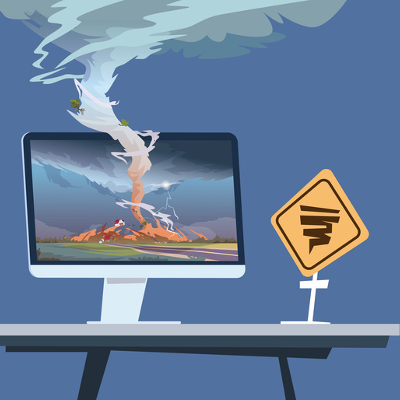You Should Care About Blockchain Technology

We often go into depth about technology, management, and other business-oriented topics, and occasionally we decide to talk about a technology that may not be all that familiar to people with the hope that a short primer on the subject will ultimately help our readers to become curious and do their own research to understand the technology better. With Bitcoin being a trending topic in the news, understanding what a blockchain is will help you understand how this technology will drive data security in the coming years.
First, What Is Bitcoin?
Bitcoin is a type of digital currency. Bitcoin doesn’t exist physically, such as coinage or paper money does, but instead exists in code form. The interesting thing about Bitcoin is how it’s generated. Users can utilize high-end computing hardware (even commercially available computer hardware) to “mine” for Bitcoin and simply invent the money. Granted, there is a limited supply of Bitcoin and generating even a small amount of Bitcoin requires a lot of computer resources and a lot of time. That said, Bitcoin has become a viable currency online for many online stores. At the time of writing this, a single Bitcoin is worth about $ 17,112 USD, compared to $ 27 back in 2009.
What is Blockchain?
A blockchain is exactly as the name suggests, a series of blocks that contain information, chained together to provide a reliable and secure accounting for whatever the blockchain is set up to measure. The technique of blockchaining originated in 1991 and was developed to timestamp documents to ensure they couldn’t be tampered with or altered. It has since been tabbed “The Internet of Value” since it functions as a form of database. The differences between traditional databases and a blockchain are numerous, however.
In a blockchain, the information that is shared is both confirmed and encrypted; and, distributed over a number of linked transactions; and, automatically replicated by each user that uses the blockchain, providing users of the chain a secure and tamper-proof ledger of secure activity. This activity can be exchanges in currency, cryptocurrency, medical records, shareholder records, etc.–any information that requires a itemized and uneditable database in which to relay information.
Uses of Blockchain
Blockchain technology has been described by industry professionals as the “new Internet”, but since a majority of people have never heard of it, we thought it would be good to provide some examples of technologies that would benefit from moving on from the centralized hosted technologies that we have today to distributed hosting like blockchain. Here are a few:
- Security: The decentralization of data makes it exponentially safter to save files in multiple locations.
- Data Management: The verification data is completely transformed and more robust with blockchain.
- Logistics: Individual goods can be traced to their origin, giving companies and consumers enhanced transparency.
- Investing: Smart contracts using blockchain provide strong security for crowd-based funding and other investment.
- Internet of Things: Provides a construct to assign automation for remote systems, and the smart contracts required to give their consumers peace of mind as many IoT devices come with some privacy concerns.
Blockchain and Bitcoin
With Bitcoin being a hot-button issue in financial circles of late; and, with other cryptocurrencies popping up all the time, you can see how blockchain technology creates a construct in which a digital currency could thrive. Since there will never be more than 21 million Bitcoins in circulation, people that choose to “mine” the Internet for this cryptocurrency do so with the understanding that today it would take a hundred years or more to mine one single Bitcoin. This ceiling protects the currency from inflation. Bitcoin miners have responded, building Application Specific Integrated Circuit (ASIC) systems to specifically mine for Bitcoins, but so many people have started to mine for them (especially as their value has started to increase) that new strategies have to be implemented in order for any of these miners are to hit paydirt, so to speak. Today, many of the so-called Bitcoin miners actually mine pools of data for small pieces of BitCoin.
What a Bitcoin is worth today is what the market for Bitcoins says it’s worth–no more, no less; and, since it uses blockchain technology, you can bet that any Bitcoin that is available, is legitimate. Since users expect almost 95% of all the Bitcoins there will ever be to be released by 2024, speculators are now saying that by then a single bitcoin could be worth a staggering $ 250,000. In fact, the demand is seemingly so high that some financial institutions have started offering investors the chance to invest in Bitcoin futures, suggesting that they completely believe in the stability of the Bitcoin market; a testament to the viability and reliability of blockchain technology.
The blockchain is definitely going to be a household name soon, but for now, we hope this article can give you a small look at the technology that will help the Internet of Things be the biggest shift in technological advancement this world has ever seen. Do you have any Bitcoin, or do you know about cryptocurrency? Do you think digital money is the future of currency? Leave your thoughts with us in the comments section below.
What Recent Natural Disasters Remind Us About Our Business

With several large storms, wildfires, earthquakes, and floods trampling major cities all over the world, the concept of data backup and disaster recovery is a particularly relevant topic. Business owners must confront whether or not they are prepared to handle such events, because if they don’t, they’ll be risking the future of their business.
According to the Federal Emergency Management Agency (FEMA), 40 percent of small businesses never truly recover from a disaster. This jarring statistic, along with every single article about data loss and disaster recovery, should be enough to convince business owners to prepare for the worst. Yet, they don’t, and it’s often too late.
To ensure that your organization doesn’t forget the most important rules of business continuity, consider the following statements:
- Your data will always be at risk, regardless of where it’s stored. No location is completely safe from a natural disaster.
- Your physical infrastructure will be affected, but so will many other organizations’.
Business continuity planning is one of the most important things that businesses fail to implement before it’s too late to do anything about it. In a recent article published in The Hartford, five businesses struggle to stay afloat following a natural disaster. They describe all of the nightmarish events that happen after the disaster, and the difficulties of recovering from such a devastating incident. Each business faced different challenges, though. One company had to repurchase machinery and inventory that was damaged during the disaster, while another simply found that most businesses they had been working with prior to the disaster were no longer in operation, thereby threatening their business with lack of sales.
If you learn any lesson from these stories, it’s that proactive thinking and planning for the future can make all the difference between your business’ survival, and its failure.
Here are seven of the most important parts of business continuity planning, and why you’ll want to focus on them.
Important Documents and Records
You need to preserve any paper documents that are critical for your business’ success. You should try to keep multiple copies of your documents for storage in both your on-site office and off-site, just in case your office isn’t left standing or is unreachable. You should consider the 3-2-1 rule as well, which we’ll go into more detail later.
Here are a few examples of important business documents:
- Deeds
- Leases
- Insurance Papers
- Certificates/Licenses
- Banking Records
- Hard Copy of Business Continuity Plan
Contacts and Communications
The most critical asset a business has is their workforce. Social media has implemented features that let users tell their friends and family that they are safe and sound, and that’s for one reason: it’s terrifying to lose contact with someone you care about during a disaster. You should establish and maintain contact lists to ensure you know who has managed to escape the wrath of the disaster. You also need to retain communication lines, including via a phone call, text message, or email. You can have a web page set up so that your employees can update you with their whereabouts in the event of a disaster, which can be helpful if they’re unable to send a voicemail or make a call. You should be especially certain that your critical staff know how important they are to operations so that you can establish modes of communication with them.
Alternative Locations and Mobility
Virtualization and mobility are the keys to ensuring that your business can survive a disaster–particularly if you want to set up a secondary location in the event your primary site is unavailable for work. Virtualization services and the cloud allow employees to work remotely as well, so even if you have no office, there might be a possibility to continue operations. In situations like this, be sure to explicitly state when you expect to resume normal operations.
Vendor and Critical Client Lists
You want to make sure that you know who your important vendors and clients are following a disaster, as they will certainly be instrumental in your recovery. You want to ensure that you can inform them of your situation so that there is no miscommunication with whether or not you can fulfill your agreements. If you are able to resume operations, you’ll want them on your side so that business as usual can resume.
Data Backup and Hardware Replacement
Your data is one of the most critical parts of your business, and without a way to recover it, you’re just another business starting over following a disaster. You must make sure that your data is backed up regularly and stored in multiple locations. Furthermore, you must test the backups to make sure they are working as intended.
Planning for Emergencies
This section mostly contains what you want to do in the event of an emergency while you’re in the office. You should set aside provisions such as flashlights, batteries, water, and more, just in case something happens and you can’t escape the office. These supplies should be stocked and checked regularly. Furthermore, you want to plan out emergency exits, meeting points, and an inventory of important items. This is all just in case you need to file an insurance claim.
Review, Update, and Test Important Components
The importance of reviewing your data backups cannot be overstated, but that’s not all you should be testing. You need to check phone numbers, a roster of key individuals, and your alternative site of operations so that you can continue operating in case of the worst.
Is your business prepared to handle the worst data loss incidents and natural disasters? To find out, reach out to us at (317) 705-0333.
Because Busy Business Owners Shouldn’t Have to Worry About Technology

A business without its own IT department will expend vast amounts of time and resources to manage its technology. Tasks like managing your email solution, upgrading or managing your desktop infrastructure, or securing your network from threats, can be draining. If you don’t have time to perform these tasks, then it’s worth it to invest in an outsourced IT provider for your technology needs.
Many organizations are faced with an increasing need for technology maintenance like never before, and they are turning their attention toward third party technology management brought to them by managed service providers. At first, this proposition might sound a bit strange. It’s difficult to justify purchasing services when you can just do them yourself. However, you’ll find that the long-term cost savings will far outweigh any costs associated with managed IT, and you’ll save both time and resources that can instead go to better purposes.
In other words, rather than spend time managing your organization’s technology, you’ll be able to focus more on running your business.
Granted, there is the option of hiring an internal IT department. Although, after looking closely at this expense you may find that this move could eventually become much more of a long-term cost than investing in an outsourced managed service provider. Paying multiple salaries could easily become much more of a problem for your budget than a simple monthly payment to a managed service provider. It’s a simple choice, but you need to consider your business’s unique needs before making it.
Some organizations believe that managed IT means giving up control over your IT infrastructure, but this is simply false. A good managed IT provider like Catalyst Technology Group will make every effort to create a transparent, trusting relationship with your organization. We believe that cooperation is the key to unlocking your business’s full potential, and a proper technology strategy is the best place to start. A proactive technology policy will be able to help you keep your operational infrastructure in proper working order.
As a managed service provider, Catalyst Technology Group offers the following services for your business:
- Network security management
- Email management
- Hardware and software procurement
- Remote maintenance and management
- Backup and disaster recovery
- Help desk support
- And more!
Does your business want to leverage technology to the best of its ability? If so, reach out to us at (317) 705-0333.

